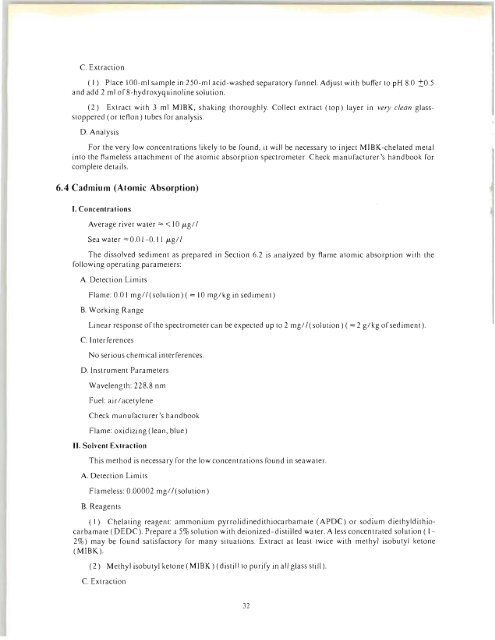You also want an ePaper? Increase the reach of your titles
YUMPU automatically turns print PDFs into web optimized ePapers that Google loves.
C. Extraction<br />
( I) Place I OO-ml sample in 250-ml acid-washed separatory funnel. Adjust with buffer to pH 8.0 :!::0.5<br />
and add 2 ml of8-hydroxyquinoline solution.<br />
(2) Extract with 3 ml MIBK, shaking thoroughly. Collect extract (top) layer in very clean glassstoppered<br />
(or teflon) tubes for analysis.<br />
D. Analysis<br />
For the very low concentrations likely to be found , it will be necessary to inject MIBK-chelated metal<br />
into the flameless attachment of the atomic absorption spectrometer. Check manufacturer's handbook for<br />
complete details.<br />
6.4 Cadmium (Atomic Absorption)<br />
I. Concentrations<br />
Average river water = « I 0 /Lg / /<br />
Sea water = 0.0 1-0.1 I /Lg / /<br />
The dissolved sediment as prepared in Section 6.2 is analyzed by flame atomic absorption with the<br />
following opera ting parameters:<br />
A. Detection Limits<br />
Flame: 0.0 I mg/ / (solution) ( = 10 mg/ kg in sediment)<br />
B. Working Range<br />
Linear response of the spectrometer can be expected up to 2 mg/ / (solu tion) ( = 2 g/ kg of sediment).<br />
C. Interferences<br />
No serious chemical interferences.<br />
D. Instrument Parameters<br />
Wavelength: 228.8 nm<br />
Fuel: air/ acetylene<br />
Check manufacturer's handbook<br />
Flame: oxidizing (lean, blue)<br />
II. Solvent Extraction<br />
This method is necessary for the low concentrations found in seawater.<br />
A. Detection Limits<br />
Flameless: 0.00002 mg/ / (solution)<br />
B. Reagents<br />
( I) Chelating reagent: ammonium pyrrolidinedithiocarbamate (APDC) or sodium diethyldithiocarbamate<br />
(DEDC). Prepare a 5% solution with deionized-distilled water. A less concentrated solution ( 1-<br />
2%) may be found satisfactory for many situations. Extract at least twice with methyl isobutyl ketone<br />
(MIBK).<br />
(2) Methyl isobutyl ketone (MIBK) (distill to purify in all glass still).<br />
C. Extraction<br />
32

















